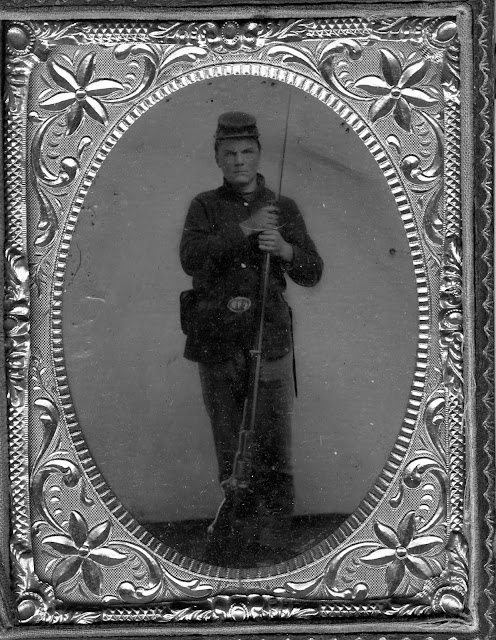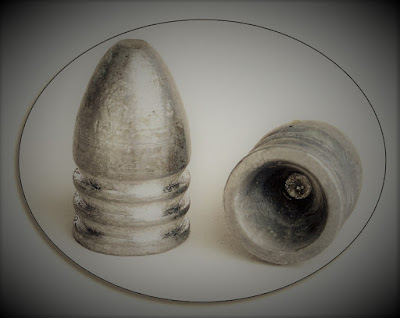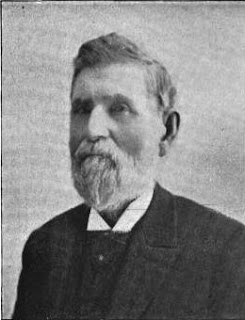“Skinned out for Memphis like Tam O’ Shanter with the devil after him” General Samuel Sturgis, the 72nd Ohio, and the Guntown Disaster
In
the days following the disastrous Sturgis expedition in June 1864, the sight in
the Memphis camp of the 72nd Ohio brought tears to the eyes of
Surgeon John B. Rice of the regiment. “It is a sad sight to go into our old
camp,” he wrote his wife on June 17, 1864. “So many familiar faces are missing,
tents are vacant, and the cheerful aspect of everything as it once was is gone.
I have delayed writing you in hopes of being able to give you some more
favorable news in regard to the loss of men in the 72nd, but the
truth compels me to say that the first accounts I wrote you were perhaps not at
all exaggerated. The loss in Buckland’s old brigade is as heavy as I have
stated and that of the 72nd will be 250 officers and men.” It was an
unmitigated disaster.
 |
| Surgeon John Birchard Rice, 72nd Ohio Infantry |
For
the 72nd Ohio Infantry, the Sturgis expedition into northern
Mississippi in the opening days of June 1864 proved the most trying days of
their Civil War experience. For nine days the regiment had tramped along the
boggy primitive roads beset by frequent rain storms and stifling heat. On the
10th day of June they took part in the supremely bungled Battle of
Brice’s Crossroads, and while disheartened at how the army had wilted in the
heat of a Mississippi summer day, casualties in the regiment had been few. But
it was the retreat that truly “tried men’s souls.”
The
expedition’s mission was of strategic import: with William Tecumseh Sherman’s
army driving the Confederate Army of Tennessee towards Atlanta, a major concern
of the Union high command was the security of Sherman’s lengthy supply lines
that ran north from Chattanooga to Nashville to Louisville on the Ohio River.
Northern Mississippi was the domain of the feared Confederate cavalry raider
par excellence General Nathan Bedford Forrest. Sherman wanted Forrest kept
busy, preferably as far away from his vulnerable Tennessee railroad lines as
possible. That job was given to troops from the District of Memphis, specifically
to General Samuel D. Sturgis. Sturgis organized a force consisting of about
5,000 infantrymen, 3,000 cavalrymen, and 16 guns accompanied by an immense
wagon train. This force set out from Memphis on June 1st and marched
cross country into northern Mississippi.
The
story of the Battle of Brice’s Crossroads has been well-covered in previous
posts on this site, specifically in one of my first posts from June 2017 that
reproduced an account from Lieutenant Rollin Edgerton of Co. E, 72ndOhio and a most recent post giving an account from Chaplain Abner D. Olds ofthe 59th U.S. Colored Troops. This post will cover another aspect of the
campaign, specifically looking at the charges that General Sturgis was both a
drunkard and a traitor. This is a story of ‘Black Jerry,’ a headquarters
ambulance full of whiskey, and a large group of seriously angry Civil war
veterans.
In
1897, Private William H. McEnally of Co. G, 72nd Ohio wrote an
intriguing article giving his experiences during what he called “the Guntown
Raid.” McEnally had been placed on detached service at headquarters at the
outset of the expedition and was ideally placed to comment on the doings at headquarters.
He bunked with a mysterious if extraordinary character, a scout he named ‘Black
Jerry.’ This scout said that he was the sole surviving member of Jessie’s
Scouts, a hard riding company of scouts organized by General John Fremont in
the opening days of the war in Missouri. They were named after the general’s
wife Jessie. “Jerry was dressed in Rebel uniform and rode a sorrel mare
equipped with a Mexican saddle,” remembered McEnally. “His duty consisted in
going ahead every day to ascertain the movements and force of the enemy. At
night he would return and report to General Sturgis. He tented and messed with
me while on the raid and of course he confided in me so I knew as much about
the situation in front as the generals,” McEnally proudly reported.
But
Black Jerry’s seedy appearance aroused the suspicions of another frequent guest
at headquarters: Lieutenant Colonel DeWitt C. Thomas of the 93rd
Indiana. He visited General Sturgis’ headquarters during the campaign and “while
there saw a man, an out-and-out Johnny (a Rebel), with the hair, clothes, etc.,
peculiar to the people of that section who appeared to be very familiar about
headquarters and my attention was therefore attracted to him. He had an old
plug of a horse and the general appearance of the guerillas we so often saw
thereabouts. I distrusted him at sight and inquired who he was; was told he was
one of the scouts and spies. I answered that he might be all right but I would
watch him as I believed he was a Rebel spy.” Colonel Thomas’ suspicions were
further aroused a few days later when Black Jerry acquired a new horse then
went out on a scout, only to return “on an old horse and in old clothes
claiming that the Rebels had captured and robbed him.” Someone had told Black
Jerry that Colonel Thomas suspected he was a spy and any time the two men saw
one another Jerry “looked as if he would like to meet me in the bush.”
Black
Jerry confided to McEnally what happened: while out on this scout he had ridden
into Forrest’s lines and found evidence that a mighty host awaited Sturgis. “He
said that Forrest had 35,000 mounted infantry and was waiting for us,” McEnally
said. “Jerry said he had reported to General Sturgis who would not believe him
and said he would go on.” The following day, Colonel Thomas saw ‘Black Jerry’
riding his horse back towards Memphis. The scout saw the colonel and rode up him.
Thomas expected trouble. “He moved his horse up near to me and said as he
leaned over its neck, ‘You will catch hell soon,” Thomas wrote. At this point,
Black Jerry disappears from the narrative of Brice’s Crossroads. One suspects
that he apprehended the danger that lay ahead and thought well to return from
whence he came…
But
Black Jerry’s appearance and disappearance helped fuel rumors that General
Sturgis was in cahoots with his Confederate antagonists. Years after the
expedition, survivors from the thousands of men captured after Brice’s
Crossroads loudly charged that Sturgis had sold them out, going so far as to
write that they had seen Sturgis (or heard the rumor) that he had sat under a
tree with Forrest the day before the battle to work out the particulars of how
he would hand over the rich wagon train to the Rebels. It was the purest bunk
but the story gained wide circulation and given the men’s utter hatred for
General Sturgis, it was evidently widely believed. “Many of the 72nd
who were at Guntown charge that Sturgis was not only drunk and a coward,” wrote
General Ralph Buckland in 1882, “but that he was a traitor and purposely
sacrificed his command.”
 |
| Major General Samuel D. Sturgis. The survivors of his botched expedition gave him a number of nicknames, among them "Old Sturgis" and "The Guntown Imbecile" |
General
Sturgis’s poor judgment at Brice’s Crossroads aroused indignation in his
troops, but his conduct prior to the commencement of the campaign had already
been fodder for many a camp fire talk. Sam Sturgis loved his whiskey and loved
it to excess. Just before the expedition left Memphis, General Sturgis went on
a very public bender. Surgeon John Rice of the 72nd Ohio wrote to
his wife that “Sturgis was crazy drunk the night before the expedition left. He
went about the city going like a mad man. He broke half the chandeliers at the
Gayoso House and conducted himself like the beast generally. After the
expedition had been gone many hours, at the latest moment he was aroused from a
drunken sleep to take charge of a body of troops of whose organization and
equipment he was ignorant and reckless.” It didn’t stop there. A private in the
120th Illinois witnessed what happened when Sturgis got off the cars
at Collierville east of Memphis. “I saw orderlies take the commander [Sturgis]
out of the car hopelessly drunk, put him on his horse, and one [orderly] rode
on each side to keep him from falling from his horse.”
 |
| General Sturgis was reportedly so drunk that he broke half of the chandeliers in the Gayoso Hotel while on a bender before the Guntown expedition. How he broke the chandeliers is open to question... |
Unfortunately,
Rice reported that both Sturgis’ staff and his infantry commander were no better
than Sturgis. “Colonel [William L.] McMillen holds his position not because of
merit but because he is a brother-in-law of ex-Governor [William] Dennison of
our state,” Rice grumped. “He is a sycophant to his superiors and a tyrant
towards inferiors and a very hard drinker. The first day out he was so drunk
that he fell and hurt himself in attempting to get out of the cars,” Rice
wrote. “The next day he was so drunk he fell from his horse. He is a vain
drunkard and a soulless scoundrel. Under the circumstances it cannot be a
matter of surprise that the whole affair was disastrous,” he concluded acidly.
Sturgis’
behavior on the field led many of his subordinates to label him a drunk. “I
well recollect that after miles of hurried marching we were halted to allow an
ambulance pass to the front,” relayed Lieutenant Isaac Peetrey of the 95th
Ohio. “When it passed it proved to be that famous headquarters ambulance loaded
with whiskey.” Upon arriving on the field, Peetrey saw “the humiliating
spectacle of General Sturgis and others on the ground at the foot of a tree a
short distance from Brice’s house all more or less under the influence of
liquor. Many were the deep and muttered curses on them.”
The
curses continued long after the war- rumors swirled that while on the retreat
Sturgis “skinned out for Memphis like Tam O’ Shanter with the devil after him,”
but he ran for a very real concern: he was worried that his own men might shoot
him. The threats continued after the war: one 72nd Ohio veteran
recalled that in 1867 General Sturgis planned to spend his summer on
Put-in-Bay, an island located just off the northern shore of Ohio near Port
Clinton, “but departed on learning that there were a number of the boys of the
72nd Regiment there, fearing that some of us would kill him.” An
Illinois veteran who was captured in the retreat and spent nearly a year in
Confederate prison camps proudly wrote that he met Sturgis on the Kansas plains
in late 1865 and told him exactly what he thought of him.
But
if there was any revenge, it came in 1882 when Dr. Gustavus Gessner, who had
been captured during the campaign while serving as hospital steward of the 72nd
Ohio, launched a letter writing campaign to bring Sturgis’ conduct on that
campaign back into the public arena. Sturgis had been relieved after the
conclusion of the expedition in June 1864 and had been investigated, but the War
Department chose to pigeon hole the report and Sturgis spent the rest of the
war in Louisville drawing a brigadier general’s salary without performing any
real duties. He remained in the army after the war and eventually became
commander of the 7th U.S. Cavalry; he made the mistake of
criticizing the conduct of his chief subordinate George Armstrong Custer
following the Little Big Horn disaster (this drew forth some spicy
correspondence that made its way into the newspapers).
In
late 1881 he was given the assignment of command of the Soldiers’ Home in
Washington, D.C. This appointment so irked Gessner that in January 1882 he sent
a letter to the Toledo Blade (a
newspaper of national readership at the time) asking for veterans of the
expedition to write to their Congressional representatives to protest the
appointment. Gessner’s call elicited a flood of letters from veterans
describing their experiences and their opinion of Sturgis (universally they
labeled him a drunken, traitorous, cowardly imbecile)- he eventually gathered a
number of them in a 70-page pamphlet called “General Sturgis at Guntown” from
which most of the accounts in the blog post reside. Sturgis wrote a defense of
his actions which the National Tribune
published, which only served to prompt a flood of letters from veterans
lambasting his defense.
General
Sturgis asked General William Tecumseh Sherman to conduct a board of inquiry to
clear his name; Sherman demurred but allowed Sturgis’ appointment to stand
despite the public outcry. Sturgis’ name provoked a hiss or growl whenever
mentioned at a 72nd Ohio reunion; the men never forgave him for his
actions on that campaign that had cost the lives of so many of their comrades. It’s
safe to say that General Sturgis never attended a reunion of the 72nd
Ohio…














Comments
Post a Comment